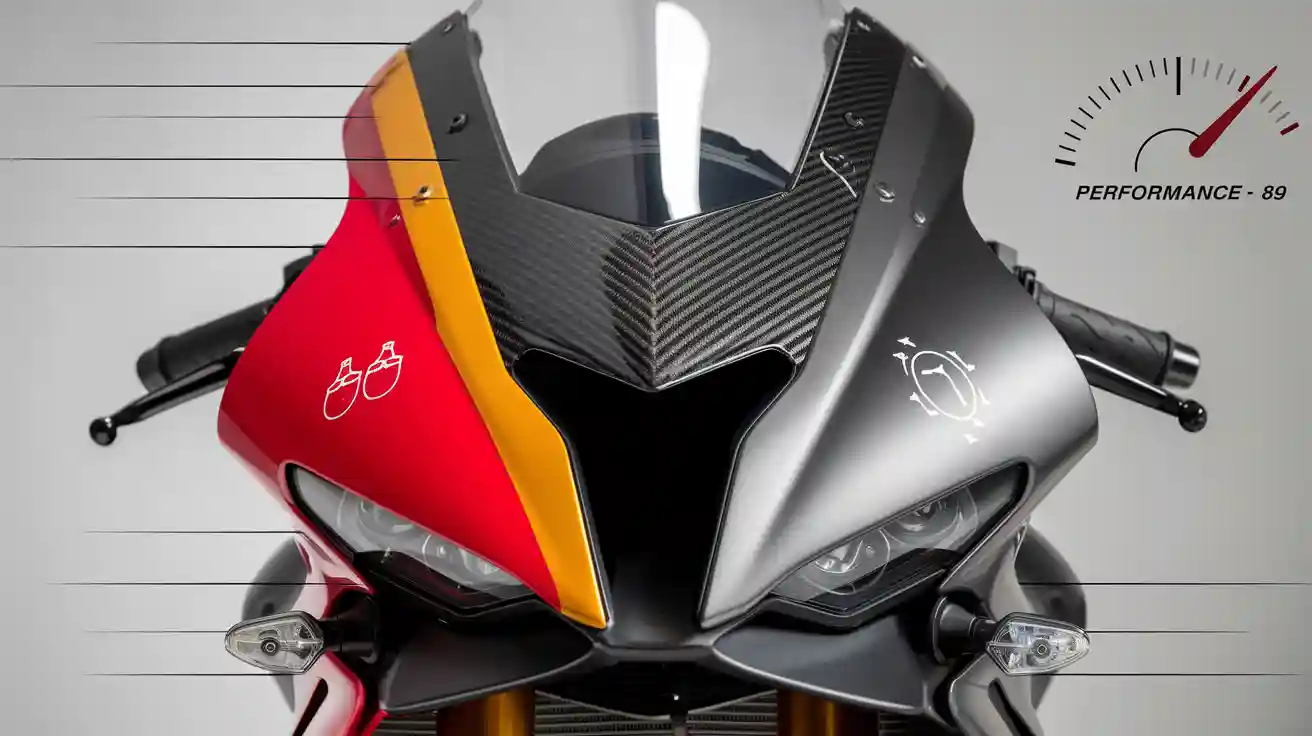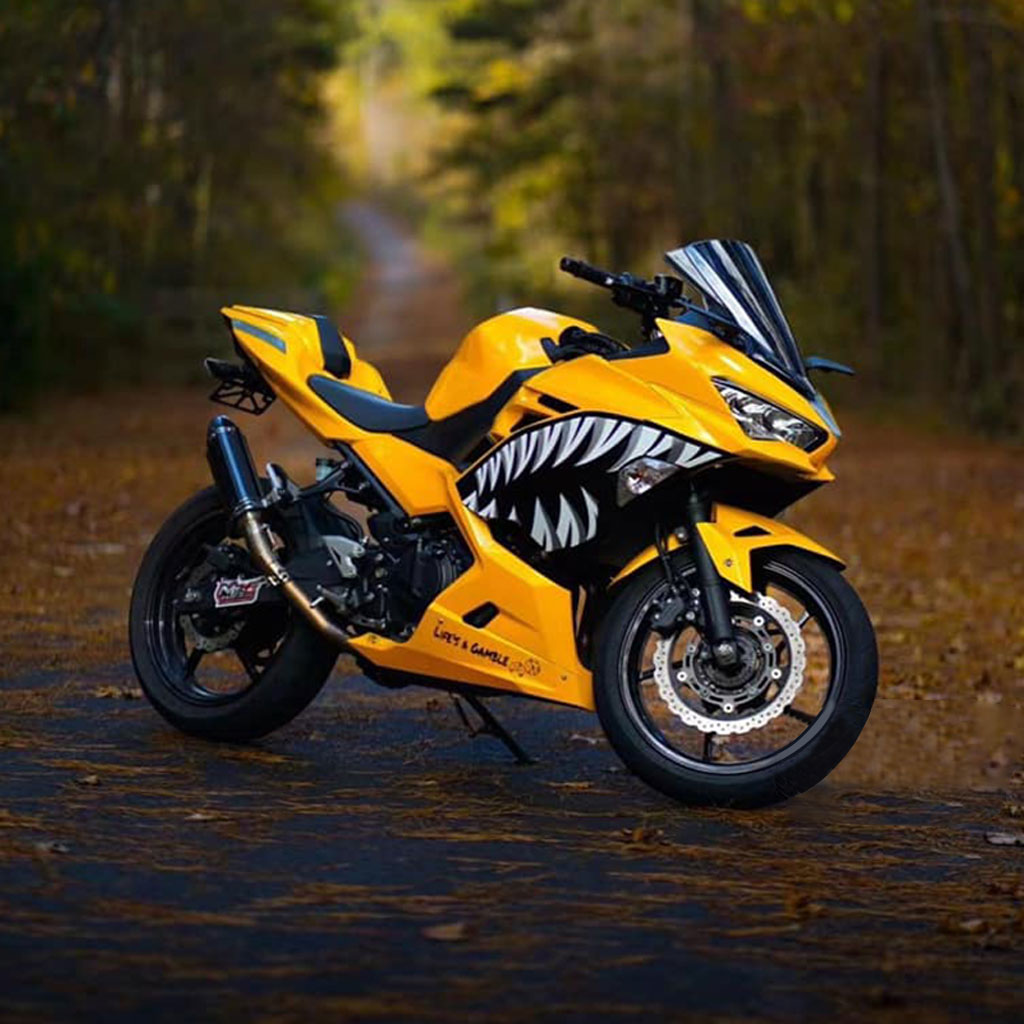Exploring R6 Fairings Materials and Their Performance Benefits

Yamaha R6 fairings play a critical role in the riding experience. Riders notice that the right fairings change how the R6 moves, handles, and feels on every road. Yamaha designs R6 fairings to support both speed and rider safety. When choosing Yamaha R6 motorcycle fairings, material choice shapes the experience on the R6. The right fairings help protect both the Yamaha and the rider. Each Yamaha R6 motorcycle fairings option can unlock a new level of performance and control for every R6 enthusiast.
Main Types of R6 Fairings Materials
Yamaha R6 motorcycles rely on high-quality materials for their fairings to deliver both performance and protection. Riders often choose between ABS plastic, fiberglass, and carbon fiber when upgrading or replacing their Yamaha R6 motorcycle fairings. Each material offers unique benefits for the R6, affecting weight, durability, and overall riding experience.
ABS Plastic R6 Fairings
ABS plastic stands as the most common material for Yamaha R6 motorcycle fairings. Manufacturers use injection molding to create these fairings, which ensures a uniform thickness and a smooth finish. ABS plastic provides a strong, flexible, and lightweight option. Riders appreciate its impact resistance and ability to withstand scratches and chemical corrosion. The design of ABS plastic fairings allows for easy installation and repair, making them ideal for daily use. While ABS plastic is heavier than fiberglass, it remains budget-friendly and offers reliable protection for the R6.
Tip: ABS plastic fairings often come with heat guards, adding extra protection for sensitive parts like the fuel tank and engine.
Fiberglass Yamaha R6 Motorcycle Fairings
Fiberglass fairings offer a lightweight and durable alternative for Yamaha R6 owners. These fairings use high-quality materials, sometimes reinforced with Kevlar, to improve strength without adding much weight. Fiberglass stands out for its repairability and corrosion resistance. Riders who seek a balance between performance and cost often select fiberglass. However, installation can take more time compared to ABS plastic. Fiberglass fairings suit those who want improved performance without the premium price of carbon fiber.
| Material | Weight | Strength | Installation | Cost |
|---|---|---|---|---|
| Fiberglass | Lightweight | Strong | More time needed | Moderate |
| ABS Plastic | Heavier | Strong | Easy and quick | Budget-friendly |
| Carbon Fiber | Lightest | Strongest | Difficult | Expensive |
Carbon Fiber R6 Fairings
Carbon fiber fairings represent the top choice for riders focused on maximum performance. Yamaha R6 motorcycles equipped with carbon fiber fairings benefit from significant weight reduction, which improves handling and responsiveness. Carbon fiber also enhances aerodynamics, reducing drag and increasing stability at high speeds. These fairings provide superior durability, heat resistance, and a premium appearance. Riders on the track often choose carbon fiber for its ability to improve lap times and offer lasting protection. However, carbon fiber remains the most expensive and challenging to install among all fairing materials.
- Carbon fiber fairings reduce overall bike weight, making the R6 easier to maneuver.
- The aerodynamic design increases downforce and stability, especially at high speeds.
- Riders enjoy a visually striking look and long-lasting performance.
Key Characteristics of Yamaha R6 Motorcycle Fairings Materials
Weight and Flexibility of R6 Fairings
Weight and flexibility play a major role in how the R6 handles on the road or track. Yamaha engineers design fairings using high-quality materials to balance these factors. Riders often choose lightweight materials to improve speed and control. The table below shows how different fairings compare:
| Material Type | Weight Compared to Fiberglass | Flexibility and Strength Characteristics | Notes |
|---|---|---|---|
| ABS Plastic (Base) | 20% lighter | Flexible for painting and accessory installation | Injection molded for precise fit |
| Reinforced ABS (Advanced) | Heavier than base ABS | Increased strength and durability | Suitable for aggressive riding |
| Carbon-Reinforced ABS (Pro) | Heaviest among ABS variants | Extreme durability and heat resistance | Carbon fiber used as reinforcement |
| Fiberglass (k300 model) | Approximately 12 kg (full kit) | Superior balance of strength and flexibility | Hand-made with flexible resin |
ABS plastic fairings are lighter than traditional fiberglass by about 20%. Fiberglass fairings offer a strong balance between flexibility and strength. Carbon-reinforced ABS provides extra durability and heat resistance, making it ideal for riders who demand more from their R6.
Durability and Impact Resistance in R6 Fairings
Durable materials protect both the Yamaha and the rider. ABS plastic stands out for its flexibility, which helps absorb impacts and resist cracking. Reinforced ABS and carbon-reinforced ABS increase durability and resilience, especially under high stress. Fiberglass fairings, often used in racing, combine strength with easy repair. Manufacturers sometimes add carbon or Kevlar to fiberglass at mounting points for extra toughness. Riders value these features because they keep the R6 looking sharp and performing well after minor accidents.
Note: Pure carbon fiber panels can be too hard and may break easily, so manufacturers often use it as reinforcement instead of a standalone material.
Cost and Availability of R6 Fairings Materials
Cost and availability influence many riders’ choices. ABS plastic fairings remain the most accessible, with aftermarket kits ranging from $250 to $400. OEM-grade ABS fairings for Yamaha R6 motorcycles can cost between $2,000 and $4,000. Fiberglass fairings, while lighter and more durable than ABS, do not have a standard price but are popular for racing. Carbon fiber fairings are the most expensive and usually reserved for high-performance or racing R6 builds. Riders should consider their budget and how often they plan to replace or upgrade their fairings.
Choosing the right materials for Yamaha R6 motorcycle fairings ensures the best mix of weight, durability, and cost. Riders who understand these key characteristics can make informed decisions for their R6.
Performance Impact of R6 Fairings Materials

Effect of R6 Fairings on Motorcycle Weight
The weight of fairings plays a crucial role in the overall performance of the R6. Yamaha engineers select materials that help reduce unnecessary mass, which leads to better acceleration and handling. When a rider named James replaced his stock fairings with carbon fiber aftermarket parts, including the tail section, front fender, and heel guards, he achieved a weight reduction of 14 lbs. This significant decrease in weight made his R6 more agile and responsive, showing how material choice directly affects the impact on rider experience.
The following table highlights how different weight categories of fairings influence handling and acceleration:
| Weight Category | Typical Weight (kg) | Common Materials | Impact on Handling and Acceleration |
|---|---|---|---|
| Lightweight | 1-3 | Carbon fiber, thin fiberglass | Improves acceleration, fuel efficiency, and agility; ideal for high-performance motorcycles like the Yamaha R6. |
| Midweight | 3-5 | Fiberglass composites, thicker carbon fiber | Balances durability and weight; offers good performance without much durability loss. |
| Heavyweight | 5-8 | Aluminum, thick ABS plastic | Adds significant weight, reducing acceleration and handling agility but increases durability. |
Yamaha R6 motorcycle fairings made from lightweight materials such as carbon fiber or advanced plastics help riders achieve exhilarating performance. These materials support performance optimization by making the R6 easier to maneuver, especially during quick turns or rapid acceleration.
Influence of Yamaha R6 Motorcycle Fairings on Aerodynamics
Aerodynamics shape how the R6 moves through the air. Well-designed fairings reduce wind resistance, allowing the motorcycle to reach higher speeds with less effort from the engine. Yamaha uses wind tunnel testing to confirm that lightweight fairings, such as those made from carbon fiber, lower drag and improve stability. Riders report that these changes lead to higher top speeds and more stable handling at high speeds.
- Fairings improve aerodynamics by reducing air resistance, allowing the motorcycle to cut through wind more efficiently and achieve higher speeds with less engine effort.
- The streamlined design lowers the drag coefficient by minimizing turbulence and wind resistance around the bike.
- Lightweight materials used in modern fairings reduce the overall weight of the motorcycle, which decreases the energy required to accelerate and maintain speed.
- Reduced turbulence from well-designed fairings leads to a more stable ride and better fuel efficiency.
- These combined effects of material choice and aerodynamic shaping contribute to increased top speed and improved handling at high speeds.
Improved aerodynamics not only boost speed but also enhance the overall riding experience. Riders feel more confident and in control, especially when pushing the R6 to its limits on the track or open road.
Protection and Safety Benefits of R6 Fairings
Safety remains a top priority for Yamaha and every R6 rider. Fairings made from fiberglass, plastic, or carbon fiber act as protective shields during accidents. These materials help protect vital components of the motorcycle and reduce the risk of injury to the rider. In low-impact crashes, fairings can absorb some of the force, shielding the rider from debris, wind, and harsh weather.
The aerodynamic design of R6 fairings also contributes to safety. By reducing wind resistance and improving stability, fairings help riders maintain better control at high speeds. This stability lowers the chance of losing balance or control, especially in challenging conditions. Riders benefit from both direct protection and the indirect safety that comes from improved handling and control.
Yamaha R6 fairings materials combine performance and safety, giving riders peace of mind and a more enjoyable experience on every ride. The right choice of fairings ensures that the R6 delivers not only speed and agility but also reliable protection for both the rider and the machine.
Choosing the Right R6 Fairings Material
Matching R6 Fairings to Riding Style
Riders must consider their riding style before choosing the right fairing kit for the R6. Track enthusiasts often select aftermarket fairing kits made from advanced materials. Professional racers prefer SIXFIBER fairings for Yamaha R6 motorcycles because these fairings are up to 60% lighter than fiberglass and offer greater strength. The flexibility of SIXFIBER allows a better fit to the frame and absorbs impacts, reducing the risk of severe damage during races. Handcrafted construction ensures durability and long-lasting performance. Racers rely on qualified mechanics for installation to maximize safety and performance. For daily riders or those who use their R6 on the street, ABS plastic aftermarket fairing kits provide a balance of flexibility, strength, and affordability. Fiberglass aftermarket fairing kits suit those who want a lighter option with manageable repairs and moderate cost.
- Professional racers choose SIXFIBER for its lightness, strength, and flexibility.
- Street riders often select ABS plastic for its affordability and ease of repair.
- Fiberglass offers a middle ground for those seeking durability and lighter weight.
Budget Considerations for Yamaha R6 Motorcycle Fairings
Budget plays a significant role in the selection of aftermarket fairing kits. Riders can find a complete fairing kit for the R6 within a range of $640 to $990. Most high-quality fairing kits in this range use high-grade virgin ABS plastic and injection molding technology. This process delivers about 95% OEM fitment quality at a fraction of the cost. The table below compares the long-term costs and maintenance for different materials:
| Material | Upfront Cost | Durability & Repairability | Maintenance & Repair Complexity | Long-term Cost Implication |
|---|---|---|---|---|
| ABS Plastic | Lower upfront cost | Strong, flexible, affordable; repairs are straightforward | Simple repairs; may be fragile under high-impact | Lower repair costs but may need replacement sooner |
| Fiberglass | Moderate upfront cost | Lighter, durable, manageable repairs | Moderate repair complexity; durable and repairable | Balanced durability and repair costs |
| Carbon Fiber | Highest upfront cost | Lightest, strongest, complex repairs | Complex and costly repairs; specialized maintenance | Highest long-term maintenance and repair costs |
Aftermarket fairing kits made from ABS plastic offer the best value for most riders. They provide durability, flexibility, and a quality finish at a lower price. Riders who want premium performance may invest in carbon fiber, but should expect higher maintenance and repair costs.
Customization and Appearance of R6 Fairings
Customization options allow riders to express their style and enhance the innovative design of the R6. Aftermarket fairing kits made from ABS plastic or fiberglass offer a wide range of paint and decal choices. Riders can request custom colors, graphics, or logos at no extra cost. Many kits include pre-drilled holes for easy installation and come with free accessories like windscreens, tank pads, and heat shields. The paint finish on high-quality fairing kits uses multiple layers of UV paint and clear coat, providing a durable and attractive appearance. Some kits mimic the look of carbon fiber, giving the R6 a premium design without the high cost.
Note: Paint finishes may vary slightly from factory colors, but most aftermarket fairing kits include a warranty against fading, peeling, or cracking.
Choosing the right fairing kit for the R6 involves balancing riding style, budget, and customization needs. Riders who understand these factors can select aftermarket fairing kits that deliver both performance and personal expression.
Riders who invest in high-quality r6 fairings see clear gains in performance, protection, and style. The right material improves aerodynamics, shields vital parts, and allows for unique customization. Choosing the best r6 fairings depends on riding style, budget, and fit. Yamaha owners often select fairings that balance durability, weight, and cost. Proper r6 fairings protect against damage and help maintain resale value. Riders should match r6 fairings to their needs, ensuring comfort and satisfaction. A smart choice in r6 fairings leads to a safer, faster, and more personal ride.
FAQ
What is the most durable material for Yamaha R6 fairings?
Carbon fiber offers the highest durability among R6 fairing materials. It resists impacts and heat better than ABS plastic or fiberglass. Riders who want long-lasting protection often choose carbon fiber for both street and track use.
Can riders install aftermarket R6 fairings themselves?
Most riders can install aftermarket fairings with basic tools. Manufacturers design ABS plastic and fiberglass kits for easy fitment. Some carbon fiber kits may require professional help due to their complexity and tight tolerances.
How do riders maintain the appearance of R6 fairings?
Regular cleaning with mild soap and water keeps fairings looking new. Riders should avoid harsh chemicals that can damage paint or finish. Applying a UV protectant helps prevent fading and cracking from sun exposure.
Are custom designs available for Yamaha R6 fairings?
Many suppliers offer custom paint, graphics, and decals for R6 fairings. Riders can request unique colors or logos. ABS plastic and fiberglass fairings provide the most options for personalization.
See Also
Comparing Nicefairings And Amotopart For Best Value
Comprehensive Guide To Motorcycle Fairings And Their Uses
Key Advantages Of Upgrading Suzuki GSXR Fairings 2006-2007

